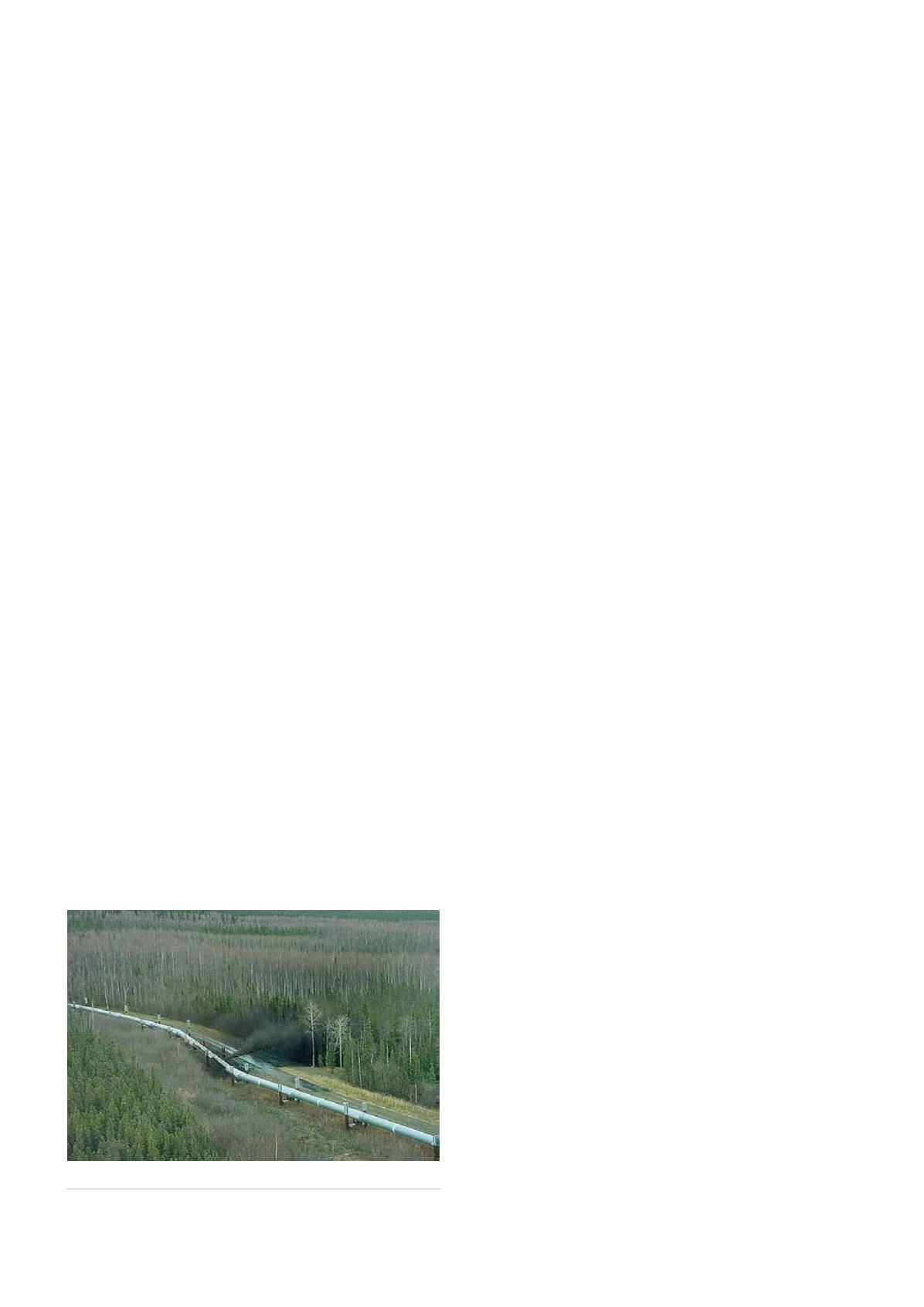
Recently, with the falling oil and gas prices, companies
have been examining new methods and technologies
that encompass accurate and effective detection tools at
reduced costs. The
Houston Chronicle
reported on
19 May 2014, that energy companies are considering using
drones to inspect offshore platforms, pipelines and flare
stacks at oil refineries.
Pipeline inspections
The oil and gas giant BP has already tested a drone for
pipeline inspections, and the Houston-based Apache Corp
has used them in the UK to monitor flare stacks at a gas
plant. In Alaska, BP is using the Puma Unmanned Aerial
Vehicle (UAV) to monitor its extensive pipeline network to
check for damage while also staying on top of weather-
related disruptions, such as icy conditions and floods.
Currently, Royal Dutch Shell is also getting into the mix
and the Oregon based VDOS Global LLC has won approval
from the Federal Aviation Administration (FAA) in 2014 to
use drones to inspect Shell’s flare stacks in the Gulf of
Mexico. VDOS says that it anticipates ‘significant demand’
for its services as a result of more than 3500 potential
inspection sites in the Gulf alone. Key advantage of drones
for these inspections: they can detect corrosion or other
problems with equipment without interrupting operations.
Commercial drone use is currently mostly prohibited
in the USA while the FAA is writing and updating the rules
for them. In 2007, the FAA imposed what amounted to
a nationwide no-fly zone on commercial drones in the
USA while it wrote rules regulating their operations. But
in March, a judge for the National Transportation Safety
Board (NTSB) said it expected to issue newly updated
regulations for the commercial regulations of drones.
In February 2015, the FAA proposed a new set of
regulations for the Unmanned Aircraft Systems (UAS)
and the US Congress passed the FAA Modernisation
and Reform Act of 2012, instructing the FAA to develop
standards for the commercial and public use of drones.
The FAA realised that UAVs and UAS are proving to be
beneficial in the energy sector. As part of FAA’s research,
it allowed ConocoPhillips Co. to use drones in the Chukchi
Sea in Alaska to survey ice and marine life.
Funding through a crude slump
Oil and gas companies are currently on the hunt for new
ways to save funds in the midst of a global crude slump
that is drying up revenue and are increasingly turning to
the tech industry for non-traditional ideas that could help
them operate faster and better than their competitors.
With the growing drone’s usage, no longer do
companies have to send workers to remote regions to
conduct routine inspections instead they are sending their
drones to do the same risky and expensive jobs that pose
potential dangers to employees.
UAS offers the industry new methods and capabilities
that decrease costs – including operational hazard – while
also improving effectiveness. UAVs and UASs can be used
to measure and quantify oil spills, determine how the oil
is moving in water and provide information and imagery,
increase safety and the ability to make better decisions
in the repairs and clean-up efforts, and additionally,
specialised sensors are also used to detect emissions of
gas leaks.
Drones have become the most economical type of
platform for the inspection of the thousands of miles
of pipelines transporting oil and gas around the world.
These infrastructures must constantly be monitored to
reduce the potential for undetected leaks, which in the
past have caused life threatening fires and explosions.
The temperature differences between fluid and soil mean
that oil and gas leaks show up well in thermal imaging.
Operators can fly drones and hover at low altitudes less
than 400 ft over the pipelines with special cameras and
sensors, sending information to the assessor showing the
pipe’s condition.
Fitted with advanced seismic sensors, drones are now
also capable to replace exploration teams by recording
and registering subterranean data from hundreds of feet
in the air. These capabilities entail a big shake-up for
one of the world’s most entrenched industries, with less
strip mining, fewer accidents, and cheaper fuel for the
consumers.
Innovative solutions
While trying to improve pipeline monitoring and
associated costs, BP began researching the use of
unmanned aircraft in 2006. Royal Dutch Shell Plc began
a year earlier, while in Canada, the two biggest pipeline
operators – Enbridge Inc. and TransCanada Corp. – still
prefer the costly traditional methods for inspecting its US
pipeline routes. In the US, ConocoPhillips is still examining
and evaluating the effectiveness of UAV monitoring.
Sky Futures – headquartered in London – is a drone
inspection company specialising in the oil and gas industry
and counts BP, Shell, Apache, BG Group and Statoil
among its clients. It is one of a handful of companies,
including Cyberhawk, PrecisionHawk and SenseFly that find
Figure 1.
Oil pipeline in Alberta, Canada bursts.
44
World Pipelines
/
FEBRUARY 2016


